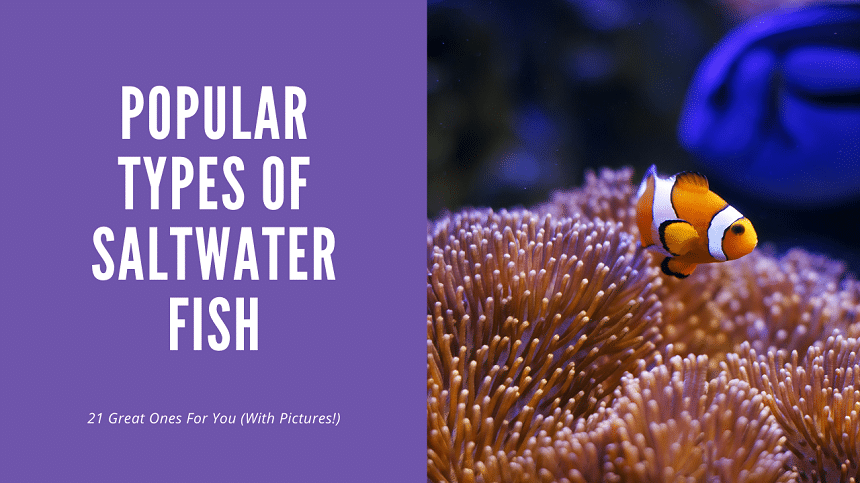Thank you for visiting! By the way… any links on this page that lead to products on Amazon and other stores/partners are affiliate links Aquarium Store Depot earns a commission if you make a purchase.
If you’re like me, you probably love spending time looking at different types of saltwater fish. It’s so much fun to admire their beauty and colors. The thing is, there are a lot of different types of saltwater fish out there and it can be tough to keep track of them all. It’s also harder to know which ones work with the aquarium you are planning to keep! That’s why I’ve put together this list of 21 popular types of saltwater fish, complete with pictures! So if you’re curious about what kinds of fish you can find in the ocean, read on!
Key Takeaways
- The average price of a saltwater fish is typical $15 to $100 depending on the species
- Examples of peaceful saltwater are clownfish and goies
- Examples of aggressive would be Pufferfish and non-reef safe Triggerfish
- Research the compatibility of any species you want to keep together
- Examples of popular saltwater would be Marine Angelfish and Basslets
Introduction To Saltwater Fish
There are believed to be more than 20,000 species of saltwater fish on this planet1. The marine aquarium hobby has taken some of the biggest and brightest fish and adapted them to the community settings found in the home aquarium with large success.
Unfortunately, most marine fish species cannot adapt to aquarium conditions. This may be due to space requirements, migratory dependency, specialized diet, or water quality. Over time, more and more species have been introduced into the hobby and optimized for the best chances at survival.
As a result, a few special ones have become favorites, like the clownfish that is the staple of every new saltwater aquarium setup. Though stocking lists may change every year based on what’s popular, there are a few species that will forever be in the home reef tank.
How Much Do They Cost?
In general, the most popular saltwater fish bred in captivity will start at about $15 with most staying under $100. Wild-caught fish tend to be at least $10 more expensive per individual, though it depends on the fish.
Because some species of saltwater fish are more popular than others, there is usually a large difference in price. This is mainly due to the most common saltwater fish being successfully captive-bred. This greatly reduces risk and yields more healthy fish, ultimately lowering prices.
Other fish that are not as common might be much more expensive than captive-bred fish. This is due to demand as well as the risks involved with obtaining and quarantining the fish. As a result, prices are higher.
In general, there are not many differences between captive-bred and wild-caught fish, though some fish, like wild clownfish, are believed to host anemones more naturally. Captive-bred fish are also usually hardier and healthier than their wild counterparts. Otherwise, the only difference can be seen in price.
It should be noted that some captive-bred fish are more expensive. This can be due to the fish species being recently bred for the first time, where supply is short but hardiness is improved.
In recent years, prices have generally risen across all fish, invertebrates, and corals. This is mainly due to various laws and fishing regulations being put into place for specimen collection and trade, like the Hawaiin ban greatly limiting the number of tangs that become available in the hobby.
Stocking A Salt Tank
Now that you have a good idea as to how much a new saltwater fish will cost you, you need to think about what kind of tank you want to set up and understand fish compatibility.
In general, there are community saltwater tanks and predatory tanks. A community tank can be stocked around a reef setting with many peaceful and semi-aggressive fish. A predatory tank will often have fewer fish stocked, with larger and more aggressive individuals.
What Is The Most Peaceful?
If you’re wanting to start a community reef tank, then you will want peaceful species that can be kept together without any problems.
Here are some of the most popular saltwater fish available that won’t attack other fish:
- Clownfish (Amphiprion sp. and Premnas sp.)
- Banggai cardinalfish (Pterapogon kauderni)
- Firefish goby (Nemateleotris magnifica)
- Yellow watchman goby (Cryptocentrus cinctus)
- Tangs
While most of these fish will live harmoniously with one another, there is always the possibility that your individual fish becomes the bully of the tank.
For instance, many hobbyists have difficulty keeping yellow tangs away from their other fish. As long as the tank is big enough, then aggression should be able to resolve itself over time, though sometimes intervention is necessary.
What Is The Most Aggressive?
Aggressive saltwater fish are some of the coolest fish available in the entirety of the hobby. These fish are often large, colorful, and full of personality.
Unfortunately, due to size and aggression, only a couple of these beautiful fish can be kept in the same tank together, but there are plenty of options to choose from.
Here are some of the most popular saltwater fish available that are not good fits for the community reef tank:
- Damselfish (most – some will be okay check here for good ones)
- Non reef safe Triggerfish
- Pufferfish
- Large angelfish
One of the most important things to remember about marine fish is that their size does not determine their aggression. For example, most species of damselfish stay under a couple of inches at maturity but they can quickly dominate a tank and terrorize other fish.
The 21 Most Popular Types For Aquariums
The first time shopping for saltwater fish at an aquarium store can be overwhelming. These are expensive and beautiful fish that you want to make sure you research before bringing them home to your own tank!
The secret to having a successful saltwater aquarium is stocking. While some fish might be right for how your tank is set up, they might not be right for the corals or other fish that you already have. When in doubt, it’s best to go with tried and true combinations.
Above is a video from our YouTube channel you can follow along. We go over more detail in our blog post below! If you like our content give us a sub. We post new videos every week!
Here is a full list of the 21 most popular saltwater fish species available!
1. Marine Angelfish

Marine Angelfish are one of the most popular saltwater fish to have in the marine aquarium. However, not many hobbyists can actually comfortably house these beautiful fish due to size, aggression, or coral concerns.
In general, both large and small angelfish are not considered to be reef-safe, though some hobbyists have luck with the smaller speices. Large angelfish can also be very aggressive, which limits them to aquariums that are only 200 gallons or more.
Large Angelfish
- Family: Pomacanthidae
- Popular Species Types: Pomacanthus, Holacanthus
- Popular Varieties: Emperor angelfish, blueface angelfish, koran angelfish, queen angelfish
- Size Range: 15-18 inches
- Origins: Atlantic, Indian, and Pacific Oceans
- Tank Size Range: 200+ gallons
- Reef Safe: No
- Available As Tank Bred: No
Large angelfish are statement fish that can be seen gliding along the perimeters of the reef, picking at algae and other sessile invertebrates they come across on the rockwork. These fish are some of the most colorful and impressive with bold markings and personalities.
However, these beautiful saltwater fish grow to extreme sizes and need large tanks. They are largely not reef-compatible, which further limits their access to most aquarium hobbyists.
Small Angelfish
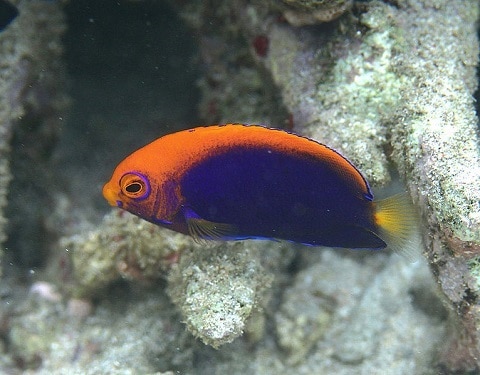
- Family: Pomacanthidae
- Popular Species Types: Centropyge, Chaetodontoplus, Genicanthus, Pygoplites
- Popular Varieties: Flame angelfish, coral beauty angelfish, flameback angelfish, Lamarck’s angelfish, rock beauty angelfish
- Size Range: 3-15 inches
- Origins: Atlantic, Indian, and Pacific Oceans
- Tank Size Range: 55+ gallons
- Reef Safe: With caution
- Available As Tank Bred: Yes
Small angelfish are some of the most popular types of angel to have in the aquarium, especially dwarf species like the coral beauty angelfish (Centropyge bispinosa) and the flame angelfish (Centropyge loricula).
These small fish can be just as colorful and aggressive as their larger counterparts but are much more manageable for the average hobbyist. Some species of small angelfish have even been successfully kept in reef settings; members of the Genicanthus are considered to be the most reef-safe.
2. Anthias

- Family: Serranidae
- Popular Species Types: Pseudanthias
- Popular Varieties: Lyretail anthias, dispay anthias, sunset anthias, squareback anthias
- Size Range: 3-8 inches
- Origins: Indo-Pacific
- Tank Size Range: 70+ gallons
- Reef Safe: With caution
- Available As Tank Bred: Uncommon
Contrary to popular belief, many of the anthias species available in the aquarium hobby are not true members of the Anthias genus. Instead, most of these schooling fish belong to Pseudanthias, feeding mainly on zooplankton and forming harems.
Anthias are fun and brilliantly colored fish in the aquarium because they can be kept in group settings. They are also reef-safe, making them an attractive addition for full reef setups. However, they heavily rely on food always being present in the water column, which can make them a little more challenging to own.
3. Basslets
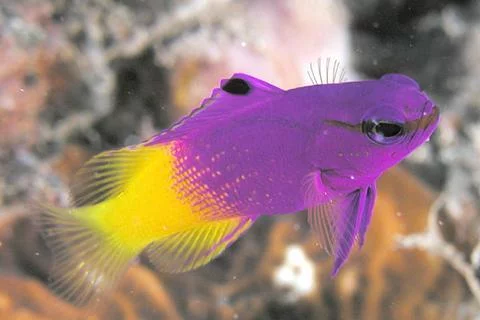
- Family: Grammatidae
- Popular Species Types: Gramma, Lipogramma
- Popular Varieties: Royal gramma, black cap basslet
- Size Range: 3-6 inches
- Origins: Caribbean, Atlantic, Indian, and Pacific Oceans
- Tank Size Range: 30+ gallons
- Reef Safe: Yes
- Available As Tank Bred: Uncommon
The royal gramma (Gramma loreto) is one of the most popular saltwater fish due to its small size and contrasting colors. However, these fish can be aggressive and aren’t always the best addition to smaller saltwater tanks.
Basslets from the Lipogramma genus are rarer to come across, though a few species become available every now and then: L. trilineatum, L. klayi, L. evides, and L. robinsi. These small fish differ from those in the Gramma genus as they originate mainly from deep reefs in the Atlantic Ocean as opposed to the tropical climate of the Indo-Pacific.
These aquarium fish may be confused with similar-looking fish from the Pictichromis genus.
4. Blennies
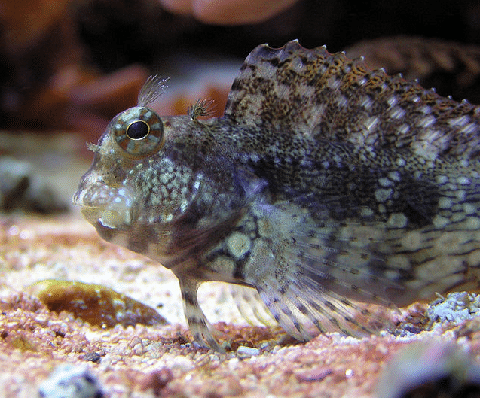
- Order: Blenniiformes
- Popular Species Types: Salarias, Meiacanthus, Ecsenius, Synchiropus
- Popular Varieties: Algae blenny (lawnmower blenny), tailspot blenny, bicolor blenny, Midas blenny
- Size Range: 3-6 inches
- Origins: Coastal waters worldwide
- Tank Size Range: 10+ gallons
- Reef Safe: Yes
- Available As Tank Bred: Uncommon
Blennies are some of the most diverse fish in the aquarium trade. These peaceful fish come in all shapes and sizes, but always remain perfect for the small community tank.
These are good beginner fish for hobbyists as they are very hardy, inexpensive, and easy to find. Aquarists should know that some of these aquarium fish are venomous, mainly those in the Meiacanthus genus.
Also, note that some other fish labeled as blenny are not scientifically true blennies, like the unrelated scooter blenny (Neosynchiropus ocellatus) that is in a different taxonomic order altogether.
5. Gobies

- Order: Gobiidae
- Popular Species Types: Elacatinus, Valenciennea, Cryptocentrus, Gobiodon, Amblyeleotris
- Popular Varieties: Yellow watchman goby, diamond watchman goby, clown goby, hi fin red banded goby, firefish goby, neon goby
- Size Range: 1-5 inches
- Origins: Coastal/tidal waters worldwide
- Tank Size Range: 5+ gallons
- Reef Safe: Yes
- Available As Tank Bred: Uncommon
There are many species of goby that may look very similar to one another but are not closely related. This results in many different shapes, colors, and temperaments between individual gobies. In fact, gobies can be found in freshwater, brackish water, and saltwater ecosystems all around the world.
Gobies are very similar to blennies but are typically smaller and more slender. Many of these small reef fish burrow into the substrate and depend on organics caught in the substrate for food, making them good members of the cleanup crew.
6. Butterflyfish
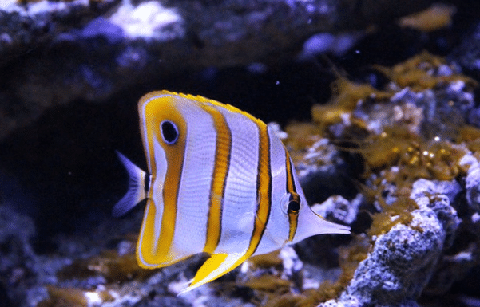
- Order: Chaetodontidae
- Popular Species Types: Chaetodon, Forcipiger, Prognathodes, Heniochus, Chelmon
- Popular Varieties: Yellow longnose butterfly, Pakistan butterfly, copperband butterfly, Heniochus black and white butterflyfish, racoon butterflyfish
- Size Range: 5-12 inches
- Origins: Atlantic, Indian, and Pacific Oceans
- Tank Size Range: 75+ gallons
- Reef Safe: With caution
- Available As Tank Bred: Uncommon
Butterflyfish are beautiful additions to the fish only or fish only with live rock (FOWLR) setup. These aquarium fish are big, colorful, and relatively peaceful. However, most species of butterflyfish have been known to nip at corals, making them incompatible with corals and other sessile invertebrates.
At the same time, some species, like the copperband butterfly (Chelmon rostratus), are some of the best saltwater fish to help with pest anemone problems.
7. Cardinalfish
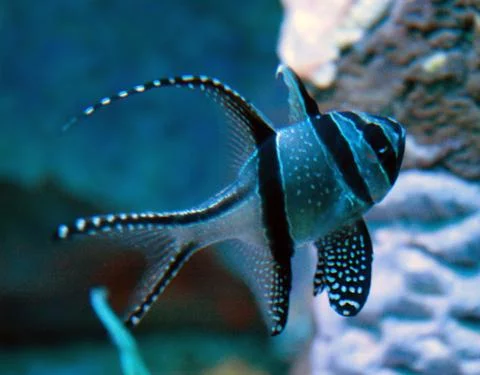
- Family: Apogonidae
- Popular Species Types: Sphaeramia, Pterapogon
- Popular Varieties: Pajama cardinalfish, Banggai cardinalfish
- Size Range: 3-4 inches
- Origins: Atlantic, Indian, and Pacific Oceans
- Tank Size Range: 20+ gallons
- Reef Safe: Yes
- Available As Tank Bred: Yes
There are only two species of cardinalfish available in the saltwater aquarium hobby: pajama cardinalfish (Sphaeramia nematoptera) and Banggai cardinalfish (Pterapogon kauderni). These mouthbrooding saltwater fish are unique with their small rounded bodies and large eyes. They are not the most colorful fish available, but their hardiness and ease of breeding make them a favorite.
It is important to note that the Banggai cardinal is a threatened species due to limited ecosystems and overharvesting. For these popular aquarium fish, in particular, try to find captive-bred individuals instead of wild-caught ones.
8. Clownfish
Best Choice For Reef Tanks!
Clownfish are hardy, full of personality, and are safe for all corals. They are an icon for any saltwater tank
- Family: Pomacentridae
- Popular Species Types: Amphiprion, Premnas
- Popular Varieties: False percula clownfish/ocellaris clownfish, percula clownfish, tomato clownfish, maroon clownfish, Clarkii clownfish, skunk clownfish
- Size Range: 3-6 inches
- Origins: Indo-Pacific
- Tank Size Range: 10+ gallons
- Reef Safe: Yes
- Available As Tank Bred: Yes
Every day, there are more and more new varieties of clownfish discovered with different markings and temperaments. These small and colorful fish rose to stardom after their starring in the Pixar animated film, Finding Nemo. Their unmistakable orange, black, and white stripes have become a staple for the home reef aquarium.
Though ocellaris clownfish (Amphiprion ocellaris) are the most popular variety of clownfish, you can find clowns with long fins or short fins, yellow or maroon coloration, and community and aggressive temperaments. No matter which species you choose, clownfish are one of the best choices for the beginner’s saltwater aquarium.
9. Damselfish

- Family: Pomacentridae
- Popular Species Types: Dascyllus, Pomacentrus, Chrysiptera, Chromis, Microspathodon
- Popular Varieties: Azure damsel, Starck’s damsel, yellowtail damsel, Springer’s damsel, three stripe damsel, Fiji blue devil damsel
- Size Range: 2-4 inches
- Origins: Atlantic, Indian, and Pacific Oceans
- Tank Size Range: 10+ gallons
- Reef Safe: Yes
- Available As Tank Bred: Yes
At the beginning of this article, we listed the damselfish as one of the most aggressive fish species you could get for your saltwater aquarium. Though their size might not seem like they could be aggressive, these small reef fish have been known to overrun a saltwater tank without mercy.
The most aggressive species of damsel is the Fiji blue devil damsel (Chrysiptera taupou) while the most community tank friendly one is the Springer’s damsel (Chrysiptera springeri). Though hobbyists have had luck keeping a Springer’s damsel in a community tank, there is always the possibility that your individual fish ends up aggressive. You lower your chances by introducing them last, having plenty of space, housing larger fish that can push back like angelfish and tangs, and lots of rockwork.
10. Tangs

- Family: Acanthuridae
- Popular Species Types: Zebrasoma, Ctenchaetus, Acanthurus, Naso
- Popular Varieties: Yellow tang, purple tang, sailfin tang, naso tang, unicorn tang, clown tang
- Size Range: 6-24 inches
- Origins: Indo-Pacific
- Tank Size Range: 70+ gallons
- Reef Safe: Yes
- Available As Tank Bred: Uncommon
Tangs are bright, active, and fun to watch in the reef aquarium. They are also constantly looking to eat algae and will continuously pick the rock clean of any food that they happen to find. However, most hobbyists can’t have tangs due to their potential size and high activity level. Some tangs, like the yellow tang (Zebrasoma flavescens) can also be unexpectedly aggressive.
In the past couple of years, the price of tangs has risen dramatically. This is in direct response to Hawaiian bans that limit how tangs are collected and exported. This is an effort to help save some currently collapsing ecosystems.
11. Rabbitfish

- Family: Siganidae
- Popular Species Types: Siganus
- Popular Varieties: Foxface lo rabbitfish, gold spotted rabbitfish, magnificent foxface rabbitfish, two barred rabbitfish
- Size Range: 6-9 inches
- Origins: Indo-Pacific
- Tank Size Range: 125+ gallons
- Reef Safe: With caution
- Available As Tank Bred: Yes
Rabbitfish are not the most popular saltwater fish to come across, but there are some benefits they can bring to the home aquarium.
Rabbitfish, especially the foxface lo (Siganus vulpinus), are excellent algae eaters that will spend most of their time picking at the live rock. One of the main attractions to this aquarium fish is their diet for bubble algae, which can be near-impossible to manage and remove otherwise.
At the same time, these hardy fish may pick at corals and have venomous spines. Caution should be used when introducing them into a reef tank setting and when putting your hands into the tank.
12. Pufferfish
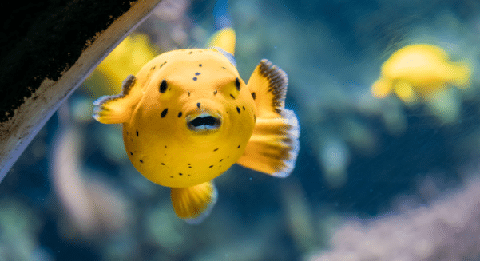
- Family: Tetraodontidae
- Popular Species Types: Canthigaster, Diodon, Arthron, Chilomycterus
- Popular Varieties: Saddle pufferfish, saddle valentini pufferfish, porcupine pufferfish, spotted puffer
- Size Range: 10-30 inches
- Origins: Atlantic, Indian, and Pacific Oceans
- Tank Size Range: 55+ gallons
- Reef Safe: With caution
- Available As Tank Bred: No
Most species of pufferfish are not reef-safe. There is a big difference between some of the largest species and the smallest ones regarding diet, temperament, and space requirements; owning a small and manageable saddle puffer (Canthigaster coronata) is much different from having a starry puffer (Arothron stellatus) that needs a 300 gallon specialized setup.
That being said, one thing is true for most of these large fish and that is that they have a toxin in their skin and internal organs called tetrodotoxin. Hobbyists don’t need to worry as this is only harmful when ingested.
13. Triggerfish

- Family: Balistidae
- Popular Species Types: Xanthichthys, Rhinecanthus, Balistoides, Melichthys
- Popular Varieties: Niger triggerfish, undulate triggerfish, humu Picasso triggerfish, blue throat triggerfish
- Size Range: 9-20 inches
- Origins: Caribbean, Indo-Pacific
- Tank Size Range: 125+ gallons
- Reef Safe: With caution
- Available As Tank Bred: Uncommon
Triggerfish are named after their unique ability to wedge themselves into the rock, only being released once their dorsal fin spine has been relaxed. In the saltwater tank setting, this rarely happens and these popular saltwater fish remain excited and active, though aggressive towards other fish.
There are several species of triggerfish commonly available in the aquarium trade. Many of these saltwater fish require large tank setups, with some being fully reef-safe and others not so much.
14. Lionfish
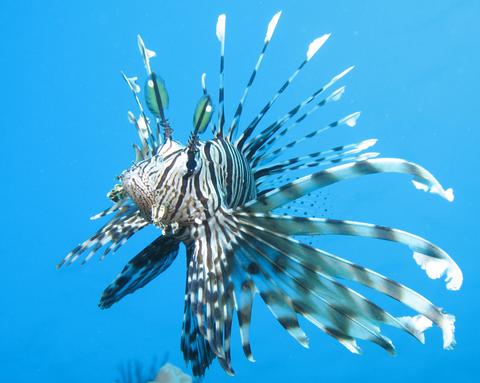
- Family: Scorpaenidae
- Popular Species Types: Dendrochirus, Pterois
- Popular Varieties: Volitan lionfish, dwarf/zebra lionfish, miles lionfish
- Size Range: 7-15 inches
- Origins: Atlantic, Indian, and Pacific Oceans
- Tank Size Range: 55+ gallons
- Reef Safe: With caution
- Available As Tank Bred: Uncommon
There is some controversy about lionfish being available as pets in the saltwater aquarium hobby. The problem is that these fish are a highly invasive species in some ecosystems throughout the world and aquarists believe that shouldn’t be capitalized on. Regardless, there are several larger species available with a convenient dwarf type that fits into smaller saltwater aquariums.
Lionfish are venomous and will inflict injury if stung by their spines. Care is needed when handling. They have a cousin named Frogfin which is a unique poisonous fish that has leg like appendages.
15. Groupers

- Family: Serranidae
- Popular Species Types: Cephalopholis, Gonioplectrus, Pogonoperca, Cromileptes
- Popular Varieties: Panther grouper, miniatus grouper, red flag grouper, blue line grouper
- Size Range: 12+ inches
- Origins: Atlantic, Indian, and Pacific Oceans
- Tank Size Range: 125+ gallons
- Reef Safe: With caution
- Available As Tank Bred: No
Groupers are very important and popular game fish in aquaculture. These great saltwater fish eat anything they can fit into their mouth and grow to extreme sizes. One of the most notable fish in this family is the critically endangered goliath grouper (Epinephelus itajara) that can reach 8 feet in length and weigh over 800 pounds.
Even smaller aquarium grouper species, like the panther grouper (Cromileptes altivelis), need to be kept in an extremely large tank to accommodate waste output and potential size.
16. Hawkfish
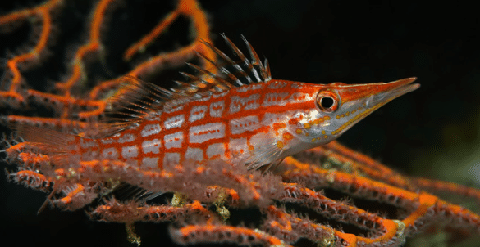
- Family: Cirrhitidae
- Popular Species Types: Neocirrhites, Neocirrhites, Oxycirrhites
- Popular Varieties: Longnose hawkfish, flame hawkfish, spotted hawkfish
- Size Range: 3-5 inches
- Origins: Indo-Pacific
- Tank Size Range: 30+ gallons
- Reef Safe: With caution
- Available As Tank Bred: No
Hawkfish are one of the less popular bottom-dwelling fish for the saltwater aquarium. These small fish earn their name from their unique behavior of perching on the rocks, diligently waiting for live food to swim past.
Though hawkfish are considered a community fish and can be reef-safe, they are very active and won’t hesitate to eat smaller invertebrates like cleaner shrimp or fish.
17. Wrasses

- Family: Labridae
- Popular Species Types: Anampses, Cirrhilabrus, Wetmorella, Halichoeres, Pseudocheilinus, Paracheilinus, Labroides, Thalassoma
- Popular Varieties: Sixline wrasse, Carpenter’s wrasse, cleaner wrasse, melanus wrasse, possum wrasse, yellow coris wrasse, fairy wrasse, cleaner wrasse
- Size Range: 3-7 inches though some species grow to be much larger
- Origins: Atlantic, Indian, and Pacific Oceans
- Tank Size Range: 20+ gallons
- Reef Safe: With caution
- Available As Tank Bred: Uncommon
With so many different species to choose from, there is a saltwater wrasse for every enthusiast. These fish come in every color imaginable, though some are reef-safe while others are not.
Some of the most notable species of wrasse are the sixline wrasse (Pseudocheilinus hexataenia), Carpenter’s wrasse (Paracheilinus carpenteri), and melanurus wrasse (Halichoeres melanurus).
Some species of wrasse can help monitor pest populations, like marine worms, in the reef aquarium, while others will heavily depend on microorganisms that already live in and around the rock.
18. Eels
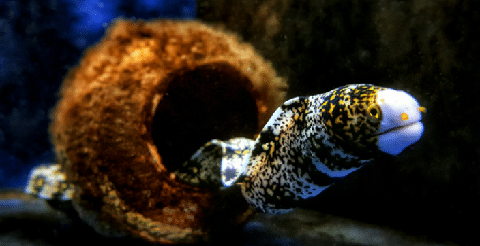
- Family: Muraenidae
- Popular Species Types: Echidna, Gymnothorax, Enchelycore, Rhinomuraena, Muraena
- Popular Varieties: Snowflake eel, blue ribbon eel, tessalata eel, jeweled moray eel
- Size Range: 12+ inches
- Origins: Atlantic, Indian, and Pacific Oceans
- Tank Size Range: 55+ gallons
- Reef Safe: With caution
- Available As Tank Bred: No
Eels aren’t the first thing you think of when you imagine a saltwater aquarium, but they can actually make a great addition to the minimal reef or predatory tank. Most species of eel get to be several feet long, but there are a few, like the dwarf moray eel (Gymnothorax melatemus cf.), that stay under a foot long.
Still, eels are incredible escape artists with a messy appetite. They need a specialized set up with lots of hiding spot, tight-fitting lid, and varied diet. Feedings need to be regularly supplemented with larger live and frozen foods.
19. Dragonets
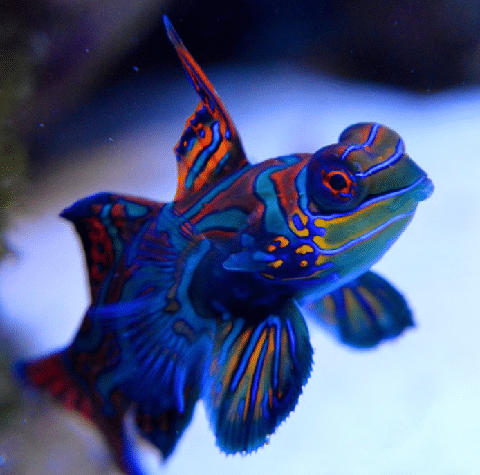
- Family: Callionymidae
- Popular Species Types: Synchiropus
- Popular Varieties: Scooter blenny, green mandarin, ruby red dragonet, red scooter dragonet
- Size Range: 3-4 inches
- Origins: Indo-Pacific
- Tank Size Range: 30+ gallons
- Reef Safe: Yes
- Available As Tank Bred: Yes
Dragonets are similar to gobies and blennies, but more demanding in regard to diet. Most species of dragonet available in the aquarium hobby, namely the scooter blenny (Synchiropus ocellatus) and green mandarin (Synchiropus splendidus), heavily rely on copepods as their main source of food.
In order to successfully keep a dragonet, the tank must be mature and regularly seeded with copepods. It may also be necessary to harvest copepods in the sump or in another aquarium to keep up with their dietary needs. Though some dragonets have successfully been moved to a frozen food diet, this isn’t guaranteed.
20. Squirrelfish

- Family: Holocentridae
- Popular Species Types: Myripristis, Sargocentron, Neoniphon, Heteropriacanthus
- Popular Varieties: Striped squirrelfish, scarlet fin soldier, big eye black bar soldierfish, glass eye squirrelfish
- Size Range: 6-14 inches
- Origins: Atlantic, Indian, and Pacific Oceans
- Tank Size Range: 70+ gallons
- Reef Safe: With caution
- Available As Tank Bred: Yes
Squirrelfish are a unique addition to the saltwater aquarium. These fish are generally peaceful, though relatively active at night since they are nocturnal; they have been known to pick at small invertebrates but are generally reef-safe. Squirrelfish are very abundant on the natural reef, which can help bring a piece of nature into the home aquarium.
Some species of this shy reef fish are venomous, but there is little to no threat to humans.
FAQS
What is the Most Common?
Clownfish are the most common saltwater fish in the marine aquarium trade. They come in many varieties, nearly all are tank bred now, and are hardy fish that get along with most fish.
What is the Prettiest?
Overall, Marine angelfish and butterflyfish are considered the prettiest saltwater fish in the aquarium trade. There are individual beauties among other species.
Final Thoughts
With so many saltwater fish to choose from, it can be difficult picking the right ones for your own mini-ecosystem. You can go with the more popular species of fish, like clownfish and tangs, or venture into the less commonly-kept fish, like eels and squirrelfish.
As long as these popular saltwater fish are compatible tank mates with each other, then you won’t have any problems! If you have any questions, leave a comment. Thanks for reading!
- About the Author
- Latest Posts
I’m thrilled that you found Aquarium Store Depot! Here you’ll find information on fish, aquariums, and all things aquatics related. I’m a hobbyist (being doing this since I was 11) and here to help other hobbyists thrive with their aquariums! I adhere to a high quality Editorial Process and Review products with real life field usage and practical analysis.

